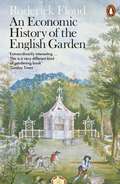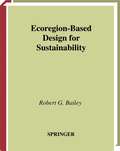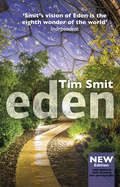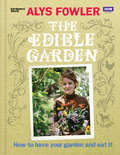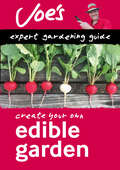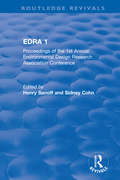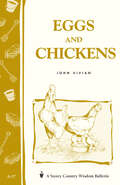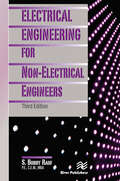- Table View
- List View
Ecological Vignettes
by Eugene P OdumFirst Published in 2004. Routledge is an imprint of Taylor & Francis, an informa company.
Ecology and the Architectural Imagination
by Brook MullerBy including ecological concerns in the design process from the outset, architecture can enhance life. Author Brook Muller understands how a designer’s predispositions and poetic judgement in dealing with complex and dynamic ecological systems impact the "greenness" of built outcomes. Ecology and the Architectural Imagination offers a series of speculations on architectural possibility when ecology is embedded from conceptual phases onward, how notions of function and structure of ecosystems can inspire ideas of architectural space making and order, and how the architect’s role and contribution can shift through this engagement. As an ecological architect working in increasingly dense urban environments, you can create diverse spaces of inhabitation and connect project scale living systems with those at the neighborhood and region scales. Equipped with ecological literacy, critical thinking and collaboration skills, you are empowered to play important roles in the remaking of our cities.
Ecology and the Architectural Imagination
by Brook MullerBy including ecological concerns in the design process from the outset, architecture can enhance life. Author Brook Muller understands how a designer’s predispositions and poetic judgement in dealing with complex and dynamic ecological systems impact the "greenness" of built outcomes. Ecology and the Architectural Imagination offers a series of speculations on architectural possibility when ecology is embedded from conceptual phases onward, how notions of function and structure of ecosystems can inspire ideas of architectural space making and order, and how the architect’s role and contribution can shift through this engagement. As an ecological architect working in increasingly dense urban environments, you can create diverse spaces of inhabitation and connect project scale living systems with those at the neighborhood and region scales. Equipped with ecological literacy, critical thinking and collaboration skills, you are empowered to play important roles in the remaking of our cities.
Ecology, Cognition and Landscape: Linking Natural and Social Systems (Landscape Series #11)
by Almo FarinaIt is more and more evident that our living system is completely disturbed by human intrusion. Such intrusion affects the functioning of entire systems in ways we do not yet fully understand. We use paradigms such as the disturbance to cover large and deep gaps in our scienti?c knowledge. Human ecology is an uncertain terrain for anthropologists, geographers, and ecologists and rarely is expanded to include the social and economic realms. The integration of different disciplines and the application of their many paradigms to problems of environmental complexity remains a distant goal despite the many efforts that have been made to achieve it. Philosophical and semantic barriers are erected when such integration is pursued by pioneering scientists. Recently, evolutionary ecology has shown great interest in the spatial processes well described by the emerging discipline of landscape ecology. But this interest takes the form of pure curiosity or at worst, of skepticism toward the real capacity of landscape ecology to contribute to the advancement of ecological science. The past two centuries have been characterized by huge changes occurring in the entire ecosphere. Global changes are the effects of human intervention at a planetary scale, with consequent degradation of the environment creating an e- logical debt for future generations. On the other side of the issue, new technologies have improved the welfare of billions of people and have given hope to many other billions that they may also see such improvement in the near future.
Ecology, Community and Delight: An Inquiry into Values in Landscape Architecture
by Ian ThompsonThis book examines the three principal value systems which influence landscape architectural practice: the aesthetic, the social and the environmental, and seeks to discover the role that the profession should be playing now and for the future. The book integrates an investigation of historical sources with contemporary research into the beliefs and values of practitioners. The book raises questions such as: should landscape architecture aspire to the status of an art form? What is the relationship between aesthetics and ecology? Does landscape architecture have a social mission?
Ecology, Community and Delight: An Inquiry into Values in Landscape Architecture
by Ian ThompsonThis book examines the three principal value systems which influence landscape architectural practice: the aesthetic, the social and the environmental, and seeks to discover the role that the profession should be playing now and for the future. The book integrates an investigation of historical sources with contemporary research into the beliefs and values of practitioners. The book raises questions such as: should landscape architecture aspire to the status of an art form? What is the relationship between aesthetics and ecology? Does landscape architecture have a social mission?
An Economic History of the English Garden
by Roderick FloudAt least since the seventeenth century, most of the English population have been unable to stop making, improving and dreaming of gardens. Yet in all the thousands of books about them, this is the first to address seriously the question of how much gardens and gardening have cost, and to work out the place of gardens in the economic, as well as the horticultural, life of the nation. It is a new kind of gardening history.Beginning with the Restoration of Charles II in 1660, Roderick Floud describes the role of the monarchy and central and local government in creating gardens, as well as that of the (generally aristocratic or plutocratic) builders of the great gardens of Stuart, Georgian and Victorian England. He considers the designers of these gardens as both artists and businessmen - often earning enormous sums by modern standards, matched by the nurserymen and plant collectors who supplied their plants. He uncovers the lives and rewards of working gardeners, the domestic gardens that came with the growth of suburbs and the impact of gardening on technical developments from man-made lakes to central heating.AN ECONOMIC HISTORY OF THE ENGLISH GARDEN shows the extraordinary commitment of money as well as time that the English have made to gardens and gardening over three and a half centuries. It reveals the connections of our gardens to the re-establishment of the English monarchy, the national debt, transport during the Industrial Revolution, the new industries of steam, glass and iron, and the built environment that is now all around us. It is a fresh perspective on the history of England and will open the eyes of gardeners - and garden visitors - to an unexpected dimension of what they do.
Economic Incentives in Sub-Saharan African Urban Planning: A Ghanaian Case Study
by Kwasi Gyau Baffour AwuahThis book explores incentives capable of enhancing the effectiveness of urban planning systems in Sub-Saharan Africa using economic theory as a framework. It argues that urban planning is fundamental to the achievement of sustainable and resilient cities, but against the backdrop of rising levels of urbanisation and growth, poverty, informal development, and climate change, such systems are failing to be promoted and successfully maintained in the region. Across ten chapters, it analyses the connection between urban planning and socio-economic development, indicators of effective urban planning systems, and the role and influence of incentives with real-world evidence. It develops quantitative models to estimate the costs and benefits of urban planning systems, focussing on the developing world where organised data is less accessible. Using Ghana as a case study, it demonstrates a step-by-step approach on how to implement the quantitative models discussed. Economic Incentives in Sub-Saharan African Urban Planning will be useful reading for researchers, policy-makers, development agencies, and students in urban planning, sustainable development, and economics.
Economic Incentives in Sub-Saharan African Urban Planning: A Ghanaian Case Study
by Kwasi Gyau Baffour AwuahThis book explores incentives capable of enhancing the effectiveness of urban planning systems in Sub-Saharan Africa using economic theory as a framework. It argues that urban planning is fundamental to the achievement of sustainable and resilient cities, but against the backdrop of rising levels of urbanisation and growth, poverty, informal development, and climate change, such systems are failing to be promoted and successfully maintained in the region. Across ten chapters, it analyses the connection between urban planning and socio-economic development, indicators of effective urban planning systems, and the role and influence of incentives with real-world evidence. It develops quantitative models to estimate the costs and benefits of urban planning systems, focussing on the developing world where organised data is less accessible. Using Ghana as a case study, it demonstrates a step-by-step approach on how to implement the quantitative models discussed. Economic Incentives in Sub-Saharan African Urban Planning will be useful reading for researchers, policy-makers, development agencies, and students in urban planning, sustainable development, and economics.
Ecoregion-Based Design for Sustainability
by Robert G. BaileyRobert Bailey is an established authority on ecosystems, and his previous works, Ecosystem Geography and Ecoregions have sold well; Fully illustrated with color diagrams and maps; Includes a Glossary to define terms which may be unfamiliar to professionals working in this cross-disciplinary field; Provides a Resource Guide and a Sources and Recommended Reading section to aid readers who require additional information; Presents a modified approach to land management and conservation in a non-technical and engaging manner
Eden: Updated 15th Anniversary Edition
by Tim SmitUpdated, with stunning new photographs At the beginning of the twenty-first century, the impossible was delivered. From the sterile depths of a disused china clay pit in Cornwall rose one of the most remarkable and ambitious ventures in recent memory. The Eden Project’s Biomes, the world’s largest conservatories, are the symbol of a living theatre of plants and people and their interdependence, of regeneration and of a pioneering forum for the exploration of possible futures. This is the extraordinary story of the Eden Project, of its conception, design and construction, of the larger-than-life personalities who made it happen and of all that has happened since its doors were first opened to the public in 2001. It is now undisputedly one of the world’s great gardens with more than 17 million visitors flocking there and projects and partnerships all over the world.
The Edible Flower: A Modern Guide to Growing, Cooking and Eating Edible Flowers
by Erin Bunting Jo FacerOn a seven-acre small holding in rural Northern Ireland, organic gardener Jo Facer and head chef Erin Bunting run fork-to-fork supper club, organic small-holding and fledgling cooking and growing school, The Edible Flower. In their first cookbook, learn to grow and cook edible flowers with Jo and Erin's delicious recipes inspired by the seasonal produce they grow in their kitchen garden and the wild food they forage from their local shores and hedgerows. Feast, celebrate and bring people together with over 50 recipes for small plates, mains, desserts, baking, snacks and drinks, at once fresh and flavourful and absolutely stunning to serve. Recipes include: Ribboned Courgette & Avocado Salad with Poppy Seeds & Calendula, Pot Marigold Soda Bread,Lilac Panna Cotta with Strawberries,Rice with Lemon Verbena, Cardamom & Edible Flower Petals,Marigold Petal Pasta,Courgette Flower Tacos,Carnation and Blackberry Cooler,Slow Roast Lamb with Lavender, Lemon & Apricots, Blackberry & Sweet Geranium Tart,Vietnamese Summer Rolls with Violas,Aubergine Katsu Curry with Pickled Magnoliaand many more ...
The Edible Garden: How to Have Your Garden and Eat It
by Alys FowlerIn this timely book, Gardeners' World's thrifty and resourceful Alys Fowler shows that there is a way to take the good life and re-fashion it to fit in with life in the city. Abandoning the limitations of traditional gardening methods, she has created a beautifully productive garden where tomatoes sit happily next to roses, carrots are woven between the lavenders and potatoes grow in pots on the patio. And all of this is produced in a way that mimics natural systems, producing delicious homegrown food for her table. And she shares her favourite recipes for the hearty dishes, pickles and jams she makes to use up her bountiful harvest, proving that no-one need go hungry on her grow-your-own regime. Good for the pocket, good for the environment and hugely rewarding for the soul, The Edible Garden urges urbanites everywhere to chuck out the old gardening rules and create their own haven that's as good to look at as it is to eat.
Edible Garden: Create Your Own Green Space With This Expert Gardening Guide (Collins Gardening)
by Joe Swift Collins BooksGrown your own food with expert gardener Joe Swift. Creating our own edible garden connects us with the natural world, improves our physical and mental health and contributes to eco-friendly and sustainable food production. If you want to learn to grow your own fruit and veg, Joe Swift shows you how with practical, easy-to-follow advice.
Edible Houseplants: Grow Your Own Citrus, Coffee, Vanilla, and 43 Other Tasty Tropical Plants
by Laurelynn G. Martin Byron E. MartinThe world of houseplants just got tastier with this colorful guide to growing edible plants indoors! Houseplant enthusiasts will be delighted to discover the range of tropical plants that can be grown in containers indoors, in any location. Laurelynn and Byron Martin, owners of Logee's Plants for Home & Garden, are nationally renowned for their expertise in growing fruit-bearing and tropical plants indoors. Their colorful guide features photos and complete care guidelines for 46 food-bearing plants, includes lemons, limes, grapefruit, cherries, olives, passion fruit, papaya, and much more. Fresh, fragrant, and flavorful, Edible Houseplants expands the fun and pleasure of growing indoor plants.
EDRA 1: Proceedings of the 1st Annual Environmental Design Research Association Conference (Routledge Revivals)
by Henry Sanoff; Sidney CohnOriginally published in 1970, EDRA 1 is a record of the conference proceedings of the 1st annual Environmental Design Research Association conference. The papers featured in this volume represent the proceedings of the conference and are concerned mainly with contributions of scientific disciplines towards the creation of improved methods of problem-solving environmental design, as well as understanding the nature of human responses to the environment. The papers included in this volume focus on developing models and methods towards a framework of coherence and definable structure of environmental design, with the ultimate objective of achieving an optimum environment for man. This volume will be of great interest to planners, architects and academics of urbanisation alike. Although published over 40 years ago, the book’s content is still as relevant and interesting today as it was at the time of publication.
EDRA 1: Proceedings of the 1st Annual Environmental Design Research Association Conference (Routledge Revivals)
by Henry Sanoff Sidney CohnOriginally published in 1970, EDRA 1 is a record of the conference proceedings of the 1st annual Environmental Design Research Association conference. The papers featured in this volume represent the proceedings of the conference and are concerned mainly with contributions of scientific disciplines towards the creation of improved methods of problem-solving environmental design, as well as understanding the nature of human responses to the environment. The papers included in this volume focus on developing models and methods towards a framework of coherence and definable structure of environmental design, with the ultimate objective of achieving an optimum environment for man. This volume will be of great interest to planners, architects and academics of urbanisation alike. Although published over 40 years ago, the book’s content is still as relevant and interesting today as it was at the time of publication.
The Education of a Gardener
by Russell PageRussell Page was one of the most famous landscape gardeners in Europe. This is his classic text describing his training and the making of his many and celebrated gardens. Written in clear, elegant prose, illustrated with a substantial photographic section, this edition boasts pictures by Marina Schinz of Russell Page's gardens in a more mature form and hitherto unpublished photographs from the author's files with a foreword and captions by Fred Whitsey, gardening correspondent to the Daily Telegraph.
The Edwardian Gardener’s Guide: For All Garden Lovers (Old House Ser.)
by Twigs WayIt is Edwardian England, and a delightful flower garden and fruitful allotment are matters of personal pride, boons for the family dinner table, and even 'important acts of local patriotism'. 'The Edwardian Gardener's Guide' selects nuggets of wisdom from the best-selling 'One & All' garden books, originally published in 1913. In these short booklets, the foremost agricultural and horticultural writers of the period revealed fashions in gardening styles, the best seasonal plants, how to enhance food production and how best to lay out adventurous rockeries, ferneries and grottoes. Packed with charming contemporary advertisements and colour illustrations, this handbook gives a glimpse of the pre-First World War 'golden era' of British gardening. With an introduction by garden historian Twigs Way.
The Edwardian Gardener’s Guide: For All Garden Lovers (Old House Ser.)
by Twigs WayIt is Edwardian England, and a delightful flower garden and fruitful allotment are matters of personal pride, boons for the family dinner table, and even 'important acts of local patriotism'. 'The Edwardian Gardener's Guide' selects nuggets of wisdom from the best-selling 'One & All' garden books, originally published in 1913. In these short booklets, the foremost agricultural and horticultural writers of the period revealed fashions in gardening styles, the best seasonal plants, how to enhance food production and how best to lay out adventurous rockeries, ferneries and grottoes. Packed with charming contemporary advertisements and colour illustrations, this handbook gives a glimpse of the pre-First World War 'golden era' of British gardening. With an introduction by garden historian Twigs Way.
Eggs and Chickens: Storey's Country Wisdom Bulletin A-17 (Storey Country Wisdom Bulletin)
by John VivianSince 1973, Storey's Country Wisdom Bulletins have offered practical, hands-on instructions designed to help readers master dozens of country living skills quickly and easily. There are now more than 170 titles in this series, and their remarkable popularity reflects the common desire of country and city dwellers alike to cultivate personal independence in everyday life.
Electric Fencing: How to Choose, Build, and Maintain the Best Fence for Your Plants and Animals. A Storey BASICS® Title (Storey Basics)
by Ann Larkin HansenExperienced farmer and author Ann Larkin Hansen offers practical advice for choosing the right fencing for your needs, planning and installing your fence, and performing ongoing testing and maintenance.
The Electric Fencing Handbook: How to Choose and Install the Best Fence to Protect Your Crops and Livestock
by Ann Larkin HansenFarmers, ranchers, beekeepers, and gardeners need effective and dependable electric fencing to keep valuable animals and crops safe. This comprehensive guide covers the different types of electric fencing, when each should be used, and step-by-step building and maintenance instructions.
Electrical Engineering for Non-Electrical Engineers
by S. Bobby RaufEngineers and non-engineers often eschew electrical engineering because it is premised on concepts and mathematical techniques that are somewhat more abstract and elusive than those employed in disciplines like civil, mechanical, and industrial engineering. Yet, because of the ubiquitous nature of electrical and electronic equipment and devices, and the indispensable role electricity plays in various facets of lives, a basic understanding of electrical engineering is essential. Engineers and non-engineers find themselves interfacing with electrical apparatus and dealing with matters that permeate into the electrical realm. Therein lies the purpose and objective of this book. This edition includes numerous updated pictures, diagrams, tables, charts, graphs, and improved explanation of certain concepts.
Electrical Engineering for Non-Electrical Engineers
by S. Bobby RaufEngineers and non-engineers often eschew electrical engineering because it is premised on concepts and mathematical techniques that are somewhat more abstract and elusive than those employed in disciplines like civil, mechanical, and industrial engineering. Yet, because of the ubiquitous nature of electrical and electronic equipment and devices, and the indispensable role electricity plays in various facets of lives, a basic understanding of electrical engineering is essential. Engineers and non-engineers find themselves interfacing with electrical apparatus and dealing with matters that permeate into the electrical realm. Therein lies the purpose and objective of this book. This edition includes numerous updated pictures, diagrams, tables, charts, graphs, and improved explanation of certain concepts.




